With the daily wear and tear, it’s easy for the car’s interior to pick up scratches. Or the frequent usage can make the interior look a little tired. But this post will help you know “how to fix scratches in car interior plastic.”
Scratches in the car interior plastic look ugly. It can decrease the vehicle’s real value when it’s time to trade in. That’s because no one wants to purchase a car with scratches. But you can fix or reduce scratches.
It’s important to try fixing car interior plastic scratches with caution as carelessness or wrong technique can worsen the problem. Your goal should be to eliminate scratches.
With these tips handy, you will no longer throw away the scratched plastic items. You can make them look better. Keep reading to know how it’s done.
Table of Contents
How To Fix Scratches In Car Interior Plastic
Here are the Steps how you can fix scratches in car Interior plastic:-
- Clean the area around the scratch with a soft, damp cloth.
- Sand the scratch with fine grit sandpaper.
- Wipe away any dust from sanding with a damp cloth.
- Apply a small amount of plastic restorer to the scratch.
- Use a clean, dry cloth to buff the restored area until it matches the surrounding surface.
Types Of Plastic Scratches
Different agents can scratch a car’s plastic trim in multiple ways. But almost all the scratches follow a type.
Different agents can cause scratches to the car’s interior plastic. Below are some common interior scratches.
Scuffs
Scuff marks are created when everyday objects like shoes or boots rub against the car’s plastic surface. An object’s exterior coloring or dirt can stick on the plastic panel.
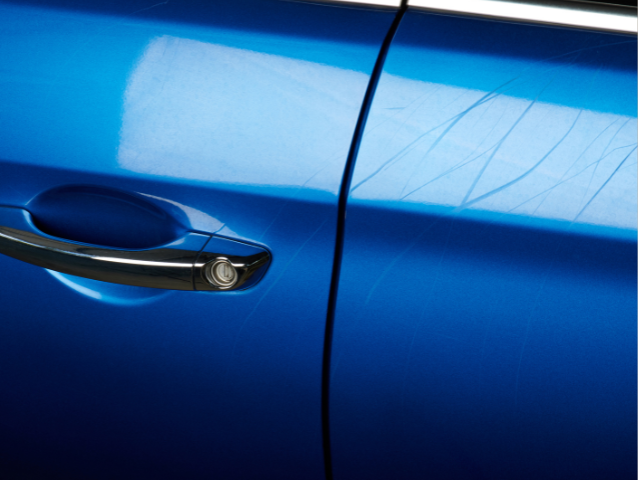
Scuff marks are common on car door sill plates and inside panels of cars. People dragging their feet when entering or exiting the cars make scuff marks. But these marks do not damage or tear the plastic surface.
Scratches
Scratches are more severe than scuff marks as they can tear plastic panel surfaces. Heavy objects like screwdrivers, pocket knives, or accidents that rub against a car’s interior plastic surfaces result in scratches.
Chips
Regular wear and tear can sometimes chip the car’s plastic panels. Chipping is more common in old cars than in new cars. Unfortunately, chips are most difficult to repair.
If your vehicle’s plastic panels have started to chip, you must preserve the breakaway pieces as getting similar-looking bits can be difficult.
Cracks
The car’s interior plastic may get brittle and crack in the high-stress areas. Areas under direct sunlight can easily crack. Therefore, you must examine your car’s interior plastic condition to locate cracks.
Steps to Remove Scratches from Your Car Interior
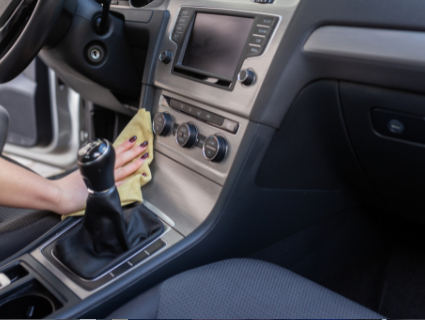
If you wish to restore the condition of your car’s interior plastic, you can follow one of the few ways listed below.
#1 Using a Heat Gun
One of the common ways to remove scratches from interior plastic is using a heat gun. You need a heat gun, interior car cleaner, and fine sandpaper for this method.
Prepare the car’s interior plastic surface for repair by properly cleaning it. Spray the interior car cleaner on a microfiber towel, and in a circular motion, rub the towel on the plastic to remove dirt and grime. Wipe off the excess cleaning solution and dirt using another microfiber towel.
Once the plastic surface gets dry, use a heat gun to apply heat to the plastic panel’s scratched area. Evenly expose the heat constantly.
Avoid heating the plastic surface for a long time as it can result in permanent damage or melt the plastic area. If the plastic surface starts getting texture, you need to stop applying heat.
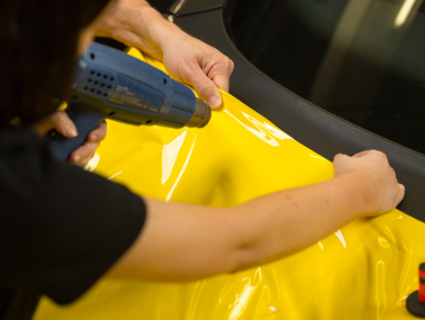
You can use sandpaper to sand down uneven areas after the surface has cooled down. It will offer an even and smooth finish. Finish the process by cleaning the repaired surface.
#2 Plastic Scratch Polish Kits
You can remove light scratches using plastic scratch polish kits. The kit includes a plastic cleaner, microfiber towels, a polishing compound, and polishing/buffing pads. A few plastic scratch polish kits also include a rubbing compound.
Using fine sandpaper, you need to smooth out the scratched area. Do not put more pressure. Gently use sandpaper on the scratch until you don’t see them anymore.
Then using a plastic cleaner, spray the plastic surface. Wipe off the dust and residue using a microfiber towel. Apply polish to the sanded area using polishing or buffing pads.
Try to get maximum polish in the scratch by polishing pads in a back-and-forth motion. After polishing the scratched areas, use another layer of polish using light pressure. Then let the polish dry. Once it has completely dried, buff off the excess polish using a fresh microfiber.
If your plastic scratch polish kit includes a rubbing compound, skip using sandpaper. You can smooth out your car’s plastic surface using a rubbing compound. You can start the scratch repair process with such kits by applying a rubbing compound to the scratched area with a microfiber towel. Use another towel to wipe off excess.
You can make the fixed surface look better by applying another layer of rubbing compound. Then apply polish to the scratched surface. Using another microfiber, buff off the excess polish.
#3 Filler Putty + Interior Grain Pads
If your car’s inner plastic has deep gouges or scratches, you can use this method to fill in and repaint. If you have got deep scratches, remove the plastic panels from the car. Removing the panel offers better access to different surfaces and sides of the panel.
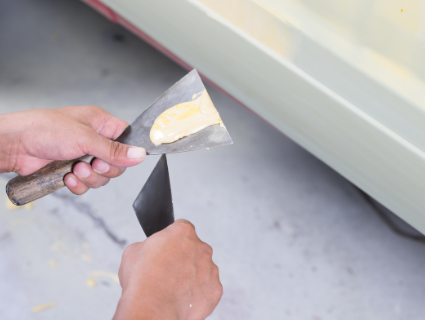
But if removing the plastic panel is not an option, use a masking tape. It will protect the nearby materials.
Start the scratch fixing process by cutting off any bits of plastic sticking out from the scratched area. Use sandpaper to sand down the scratches. Clean the thoroughly sanded surface.
Take a microfiber towel and spray the car’s interior cleaner on it. Remove debris and dirt from the plastic panel’s surface by rubbing a microfiber towel. Using a fresh microfiber towel, wipe off the dirt, debris, and grime.
Then you need a grain pad that can be used for the filter putty. Using a surface sealant and protectant, you need to spray a small panel section. Then take a hot glue gun to apply hot glue to the separate plastic pieces that are bigger than the scratched area.
Stick the glued side of the plastic piece on the panel section that you have sprayed with sealant. Take out the plastic piece after the glue dries. If you pull off the plastic piece carefully, the texture of the glued side of the plastic piece will match the panel’s factory grain pattern.
You then need to apply body filler putty on the scratch surface. Use a razor to spread the putty on the scratched area evenly. Use a glued piece of plastic to imprint the puttied area when the putty is drying. After the putty dries completely, spray the entire plastic panel with paint similar to the panel. Let the paint dry.
#4 Make Vehicle Plastic Interior Look New
Once you have removed the scratches from the plastic interior of your vehicle, you must bring back the shine. For this work, use an advanced nanotechnology product that can enhance plastic by changing its molecular structure.
When using a product to make the plastic interior look new, gently wipe the surface using a microfiber towel. Then apply the product to the surface. Let the product stay on the surface for some time. If you are not satisfied with the results, apply a second coat. Use a towel to remove the extra product.
#5 Replacement Panel
While some car interior plastic scratches can be fixed, some scratches are beyond repair. Damage happens when a heavy object is pushed or dropped on the plastic surface.
If that is the case, you need to search for a replacement panel similar to the color of your scratched panel. You can find plenty of options online.
How to Fix Scratched Plastic in Car- DIY Steps
If you want to fix the car interior plastic using household hack, you would need baking soda, toothpaste, and sandpaper.
#1 Toothpaste or Baking Soda
You can use mild abrasives like baking soda or toothpaste to remove scratches from the inner plastic. This cheap DIY household hack is simple to execute.
For this, you need to clean the scratched surface with a car interior cleaner properly. Dry off the cleaned surface with a towel. Then apply baking soda or toothpaste to the surface with a damp cloth. Rub the cloth on the scratched surface till the scratches disappear.
Remove debris and excess toothpaste using another towel. This method will do wonders if the scratches are light, almost superficial.
#2 Wet Sand for Deeper Scratches
Using wet sandpaper can level out the plastic surface with a better force. That’s because moisture keeps the material from building up in the sandpaper. It makes sure the plastic does not get scratched any further.
To use wet sandpaper for deeper scratches:
- Soak a piece of 800-grit sandpaper in water.
- Let the sandpaper stay in the water for a couple of minutes.
- Use the wet sandpaper to sand out the scratched area gently.
Avoid applying more pressure as it might invite new scratches. Rewet the sandpaper several times through the process to evenly sand down the area. At last, apply plastic or acrylic polishing compound to make the fixed surface shine like new.
Things to Avoid
This section will help you know about the chemicals you must avoid putting or using near a car’s plastic interior.
- Keep household cleaners away as they are one of the most dangerous things that a car’s interior plastic panels can be exposed to. Household cleaners can discolor the plastic panel they are applied to. If that happens, you would have to repaint the affected area with the proper color.
- Keep the blowtorch away as one blows out the fire and the other blows warm air. A blowtorch can melt down the plastic, causing more damage. Even half a second of exposure can cause great damage.
- Keep coarse sandpaper away from the vehicle’s interior plastic. The coarse sandpaper can cause more scratches. Rough sandpaper can cause permanent damage. It’s always advisable to choose sandpaper with a grit of 1200.
- You might also want to stay away from spray paint as it can spread to unwanted places. In such a situation, you would have a very hard time cleaning up.
How to Avoid Further Damage in the Car
Remove Dust And Dirt
You can use a vacuum or a plain cloth to remove the layer of dust from the car’s plastic parts. Comparatively, vacuuming is a better way as it can quickly remove dirt and dust particles from the inner plastic surface.
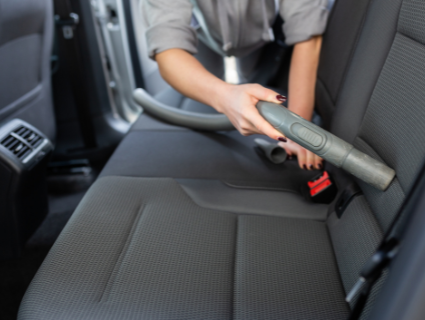
The benefit of vacuuming is that you might vacuum the entire car, like a deep clean. Clean the crevices and cracks so that you can eliminate maximum dust.
Dust The Surface
After eliminating larger dust particles from the vehicle, you must eliminate the remaining dust particles. You can wipe down the car from the dashboard to the car using a cloth damped in the water. Try to get into smaller spaces around buttons and gear shifts on the dashboard.
Use an old toothbrush, Q-tip, or paintbrush to remove dust from hard-to-reach areas properly. Dry the surface with a cloth.
Use Cleaning Products To Remove Stains
You can remove dust by vacuuming or wiping the surface, but you will require a heavy-duty product to remove stubborn spots or stains present on the interior plastic of the vehicle. You can find several cleaning products for this work in the stores.
You can polish the car’s interior plastic using laundry detergent, mild soap, or plastic cleaning products. After using the product, dry the surface with a piece of clean cloth.
Frequently Asked Questions
Can you remove scratches from the plastic?
To remove scratches from hard plastic, clean the plastic surface using a damp cloth. Apply baking soda or toothpaste to the scratched area. Lastly, wipe the area.
Can I fix interior plastic scratches?
Yes, interior plastic scratches can be repaired using methods like using plastic polish, applying a vinyl repair kit, or employing a heat gun to gently blend the scratch into the surrounding plastic.
How do you fix scratches on a dashboard?
To fix dashboard scratches, clean the area, use a plastic or vinyl repair kit to fill the scratch, sand the repaired area, and apply matching dashboard paint or dye.
How do you remove black scuff marks from plastic car interior?
To eliminate black scuff marks from a car’s plastic interior, use a clean cloth with a gentle plastic cleaner or mild detergent. Gently rub the scuff mark until it vanishes.
Wrapping up
Car interior plastic scratch is a common occurrence, but it looks bad. In addition, it can decrease your car’s value. For this reason, you must remove the scratch from the interior plastic immediately.
But you must carefully remove the scratches as overdoing them may ruin the look of the plastic surface. You can also purchase scratch-preventing polishes that keep your car’s interior plastic in good condition.
Try to keep the car’s interior plastic away from things mentioned at the end of this post.
